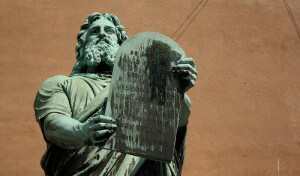Separation of Church and State: Where Exactly is the Line?
August 2nd, 2016

Religious monuments on state ground are continually being challenged by the ACLU on the grounds that they promote one specific religion.
The First Amendment of the United States constitution effectively gave us the separation of church and state that we know today. The First Amendment contains two cornerstone clauses by which the founding fathers emphasized this separation. The Establishment Clause and the Free Exercise Clause prevent Congress from prohibiting the exercise or the regulation of religion. Despite this constitutional mandate, the U.S. Supreme Court has struggled with finding a balance between truly upholding the notion that congress should not interfere with religion while simultaneously avoiding a precedent that would allow entities to do nefarious things like commit murder in the name of religious sacrifice.
When we think of conflict concerning the line demarcating the separation of church and state we often think of in-school prayer or the words “under God” in the Pledge of Allegiance. One particular issue that pops up from time to time is a state’s right to install a religious monument on state grounds.
The Ten Commandments: Oklahoma’s Battle Continues
In 2009, the Republican-controlled Oklahoma Legislature authorized a privately funded granite monument depicting the Ten Commandments to be erected on Oklahoma Capitol grounds. In 2012, the monument was completed and then installed at the capital and has been a beacon of controversy ever since. In fact, in 2014 a man drove into the monument, claiming Satan directed him to destroy it. It was subsequently repaired.
The American Civil Liberties Union (ACLU), claiming that it is unconstitutional for the state to promote one particular faith over others, filed lawsuit against the state of Oklahoma in 2013. In a 7-2 ruling, the Oklahoma Supreme Court ruled in favor of the ACLU ultimately stating that the monument being placed on capitol grounds violated Article 2, Section 5 of the Oklahoma State Constitution. The relevant Section 5 prohibits state money or property from directly or indirectly benefiting a religious group.
The monument was moved to another location at taxpayer expense and although Oklahoma Governor Mary Fallin called for an amendment to the Oklahoma Constitution, as of yet, none has been made.
How Does the U.S. Supreme Court Feel About Religious Monuments Being Placed on Public Grounds?
Although the placing of a Ten Commandments monument on state ground may appear to violate the separation of church and state provisions of the U.S Constitution, the U.S. Supreme Court found otherwise in the case of Anderson v. Salt Lake City Corp. In its 1973 ruling, the court found that simply placing a Ten Commandments monument on public property did not violate the First Amendment.
In order for a monument of this type to violate the United States Constitution, it would have to have the primary purpose of promoting religion. To demonstrate this prohibited purpose, it appears the court may look at the nature of the monument, the group that donated it and the intent of the governing body in placing the monument on public grounds.
It is unlikely that we have heard the last argument of this nature, and Universal Life Church is dedicated to keeping up to date on all matters affecting religion and the law.


